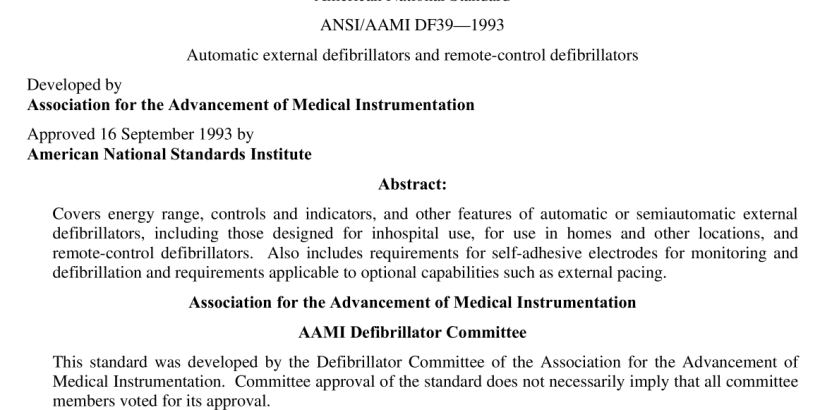ANSI AAMI DF39-1993 pdf download
ANSI AAMI ID54-1996 pdf download.Automatic external defibrillators and remote-control defibrillators
1.1 General
This standard covers minimum labeling, performance, and safety requirements for automatic or semi-automatic (advisory) external defibrillators (AED), remote-control defibrillators (RCD), and self-adhesive combination electrodes. An AED is an electronic apparatus that includes sensors and analysis algorithms capable of identifying ventricular fibrillation (VF) and other electrocardiographic (ECG) rhythms. The AED is connected to a patient and delivers a brief electrical shock to the heart if the device indicates VF or other arrhythmias for which a shock is appropriate. The defibrillator shock is delivered automatically by the device in the case of an automatic defibrillator, or is delivered by the operator (upon recommendation from the device) in the case of a semiautomatic or advisory defibrillator. An RCD transmits an ECG by telephone to a medical response center and is remotely operated from that center. Self-adhesive electrodes for monitoring and defibrillation, which are a necessary and important component of AEDs and RCDs, are also covered by this standard. Algorithms for prompt and accurate identification of cardiac rhythms, particularly VF, are an essential requirement for the performance and safety of AEDs. Though it is difficult to develop a traditional standard for a VF detection algorithm, this standard defines minimum testing and reporting procedures for describing and verifying the performance of the arrhythmia detection component of the AED. Only ECG rhythm detectors are considered, as it is premature to specify and standardize requirements for other non-ECG rhythm detectors which may be developed and used in the future. AEDs may be designed specifically for hospital use, for prehospital use by emergency response teams, or for use in homes or various locations (factories, airplanes, etc.). This standard recognizes and covers the differentiation of requirements for these various applications.
2.2.1 automatic external defibrillator (AED): A defibrillator that analyzes the cardiac rhythm, identifies shockable rhythms, and includes logic circuitry to automatically operate the defibrillator when a shockable rhythm (ventricular fibrillation [VF] and certain forms of ventricular tachycardia [VT]) are detected. 2.2.2 event documentation: A sufficiently detailed record of events and activities surrounding an episode of cardiac arrest and attempted defibrillation or pacing. The record, which includes ECG traces and may include voice recording, allows a retrospective analysis of the event for purposes of medical control, quality assurance, and further operator training. 2.2.3 external defibrillation: The application of a high-energy, short-duration electrical discharge to the heart (myocardium) by means of electrodes placed on the body surface at appropriate locations, in an attempt to terminate VF and restore an organized, perfusing cardiac rhythm. 2.2.4 external transcutaneous pacer: A device that may analyze the ECG and that delivers pacing pulses to the heart, at a controllable rate and current, by means of electrodes placed on the body surface. 2.2.5 pacing: The application of moderate-energy, very short-duration pulses to the heart, at a controlled current and frequency, to achieve cardiac contractions of appropriate strength and rate in case of complete AV block or extreme bradycardia. In transcutaneous external pacing, electrodes placed on the body surface are used to sense the cardiac rhythm and to deliver the pacing pulses. 2.2.6 remote-control defibrillator (RCD): A defibrillator that is connected by a communication link (usually a landline telephone) to a medical response center, and that is remotely controlled and operated from the response center. See section 3.5 for detailed definitions of RCDs and communication links. 2.2.7 rhythm recognition detector: An algorithm that analyzes the ECG and identifies the cardiac rhythm. The algorithm in an AED is designed for maximum sensitivity and specificity.
